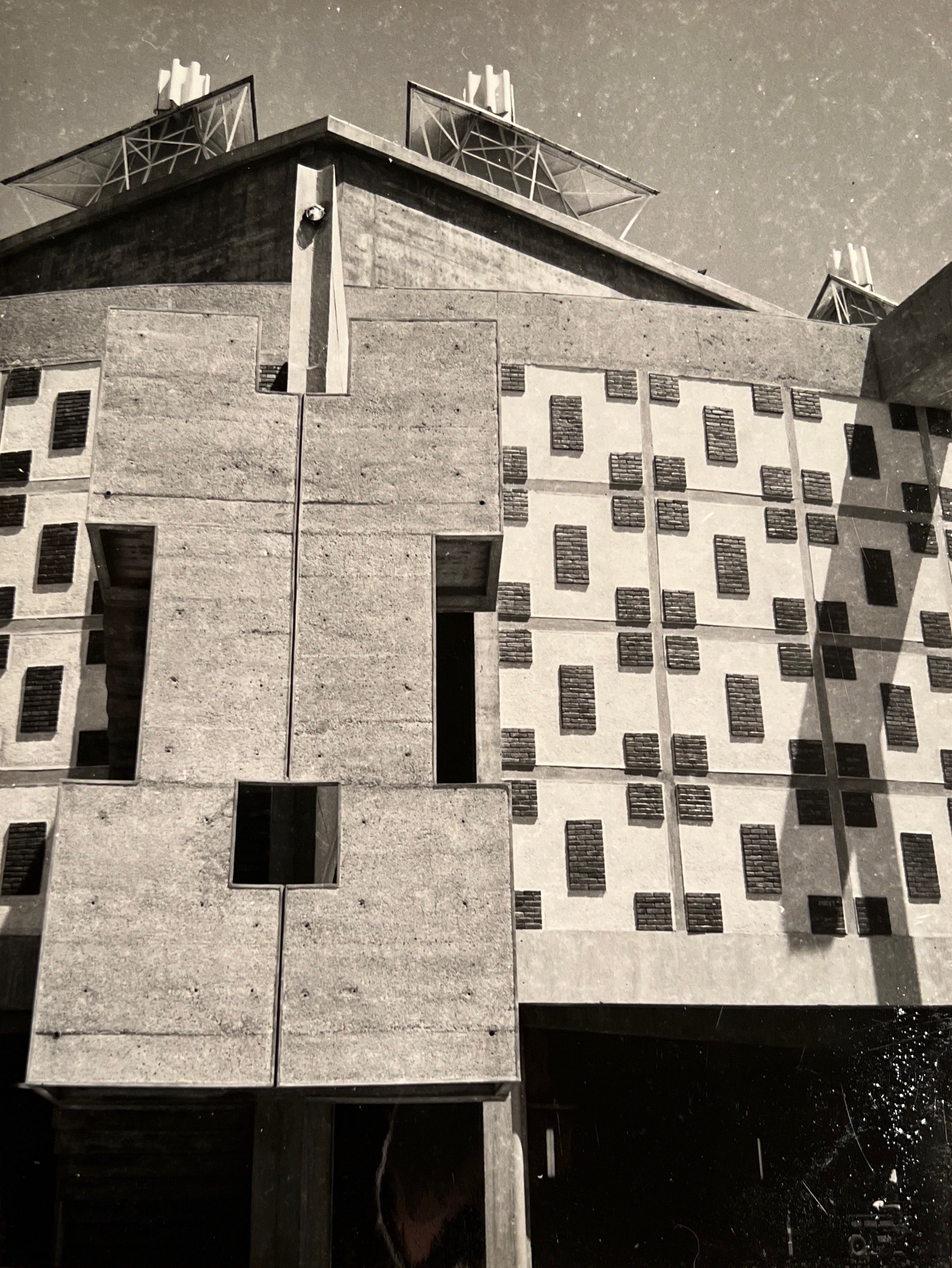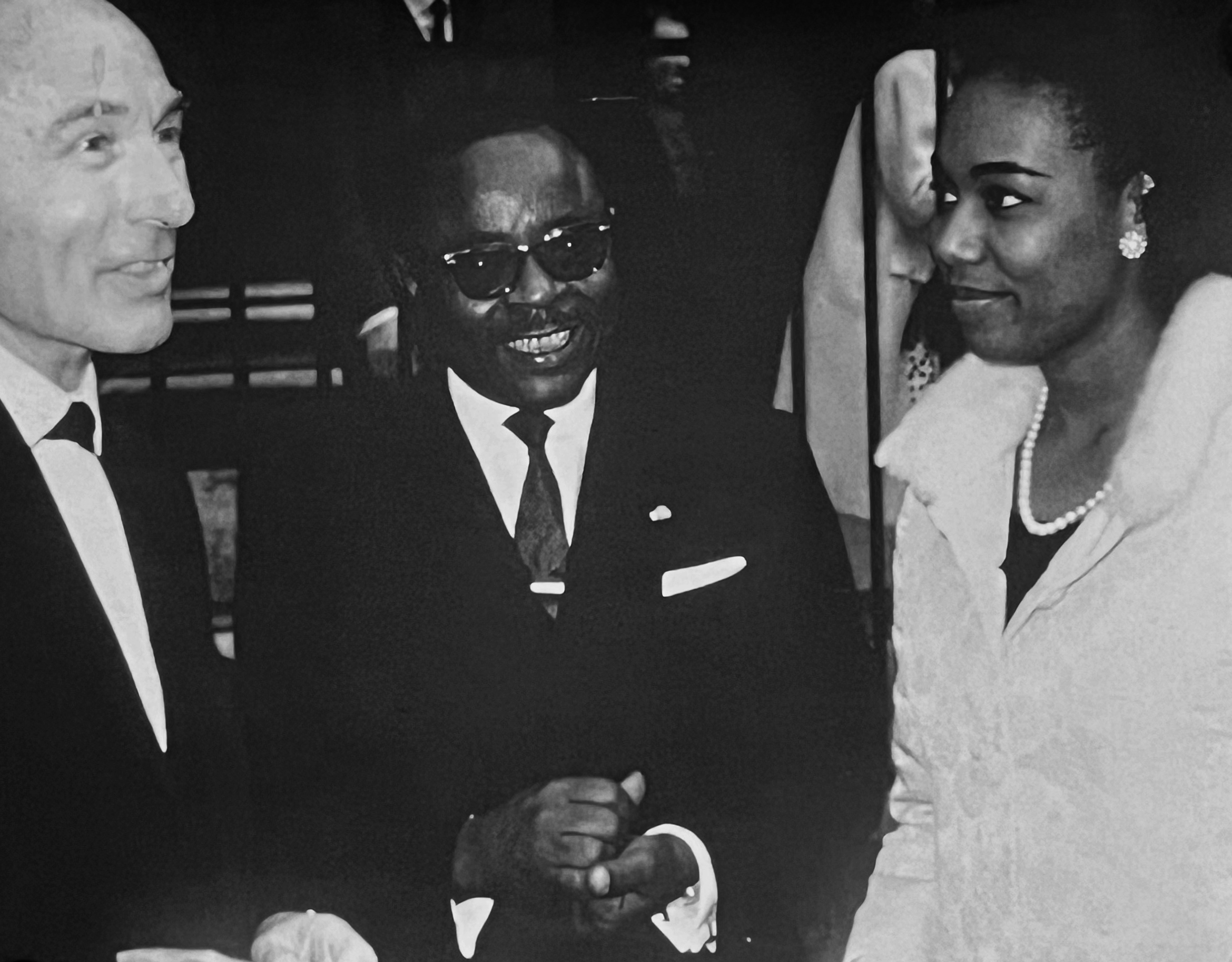La Maison du Peuple, or “The People’s House”, is one of the most significant examples of African Modernism and a critical cultural heritage site in Burkina Faso. The complex embodies a history of nation-building and appropriation by the Burkinabé public. Its continued use as a performance venue and space for public assembly has made Maison du Peuple an anchor for cultural memory in Ouagadougou.
![]()
The French architect of Maison du Peuple, René Faublée, struggled with fragile health during his life. Upon graduating from l'Ecole parisienne des Beaux-Arts in 1934, he went to seek fresh air in the mountains where he received training under Henri Jacques Le Même. He received first prize in a ski chalet competition with architect Michel Luyckx.10 During this time, Faublée developed his architecture in relation to the vernacular French alpine style, first building a home for his parents in Morzine, and then a series of ski chalets.
![]() Faublée’s introduction to Africa came when he was stationed on the continent during the Second World War, working in Algeria and eventually Morocco (often in collaboration with Michel Luyckx). In Morocco, Faublée designed two ski projects - one in Ifrane and the other in Oukaimeden where he experimented with modern and vernacular construction techniques and logics.11
Many architects completing their service during the war experienced an increased reliance on local materials and techniques due to stilted importation and transportation networks during the war.
Faublée’s introduction to Africa came when he was stationed on the continent during the Second World War, working in Algeria and eventually Morocco (often in collaboration with Michel Luyckx). In Morocco, Faublée designed two ski projects - one in Ifrane and the other in Oukaimeden where he experimented with modern and vernacular construction techniques and logics.11
Many architects completing their service during the war experienced an increased reliance on local materials and techniques due to stilted importation and transportation networks during the war.

The French architect of Maison du Peuple, René Faublée, struggled with fragile health during his life. Upon graduating from l'Ecole parisienne des Beaux-Arts in 1934, he went to seek fresh air in the mountains where he received training under Henri Jacques Le Même. He received first prize in a ski chalet competition with architect Michel Luyckx.10 During this time, Faublée developed his architecture in relation to the vernacular French alpine style, first building a home for his parents in Morzine, and then a series of ski chalets.
 Faublée’s introduction to Africa came when he was stationed on the continent during the Second World War, working in Algeria and eventually Morocco (often in collaboration with Michel Luyckx). In Morocco, Faublée designed two ski projects - one in Ifrane and the other in Oukaimeden where he experimented with modern and vernacular construction techniques and logics.11
Many architects completing their service during the war experienced an increased reliance on local materials and techniques due to stilted importation and transportation networks during the war.
Faublée’s introduction to Africa came when he was stationed on the continent during the Second World War, working in Algeria and eventually Morocco (often in collaboration with Michel Luyckx). In Morocco, Faublée designed two ski projects - one in Ifrane and the other in Oukaimeden where he experimented with modern and vernacular construction techniques and logics.11
Many architects completing their service during the war experienced an increased reliance on local materials and techniques due to stilted importation and transportation networks during the war.
Between 1961 and 1973, Faublée made several trips to Africa and was actively designing in the region. After Upper Volta (now Burkina Faso) gained independence from the French in 1960, Faublée received a commission from Conseil de L’Entente (a regional cooperation organization) to complete headquarters in Ouagadougou, Niger, and the Ivory Coast. The same year, he designed a building for the Governor General of French West Africa at 159 Boulevard Haussmann in Paris (it would later become the Embassy of Burkina Faso).
![]()
During this period Faublée was selected by the first President of Burkina Faso (then known as Upper Volta), Maurice Yaméogo, to complete a building in Ouagadougou for his ruling party. They would strike up a friendship, and Faublée would also design the President’s home, known as “Palais Yameogo” in Koudougou the same year.
![]()
In Ouagadougou, La Maison du Parti (now known as La Maison du Peuple) was inaugurated in 1965–consisting of a 2,500-seat theater, a hall of honor, two vast pavilions, a track, a technical cabin for radio broadcasting, as well as restaurants and bars on a large courtyard. René Faublée’s son, artist Michel Faublée, supervised the construction.12 The building is surrounded by an original stone block fence with a sculptural pivoting gate at the site’s entrance. The entrance is flanked by two elephant sculptures, a symbol of Yaméogo’s ruling party UDV-PRA. Faublée developed a shared aesthetic between Palais Yameogo and Maison du Parti, employing the same ‘situated’ Modern style; featuring passively ventilated facades, patterned walls, and concrete coloured to match the earth of the building’s surroundings. Maison du Parti’s design distinctively featured a series of ventilated skylights reminiscent of ‘hats’ or ‘lanterns’ that resemble traditional roofs in Mossi architecture. The main building volume is raised on pilotis on the south side, with six segregated stair volumes carrying visitors from the ground floor plaza to the auditorium level. The north side of the building is flanked by two monolithic ramps nestled between mature existing trees, bringing visitors up to the first floor. On the exterior facade, sculptural downspouts carry water from the roof of the building to the ground. The interior of the building features a distinctive triangular waffle slab ceiling with lighting integrated into the circular vertices between the triangles.

During this period Faublée was selected by the first President of Burkina Faso (then known as Upper Volta), Maurice Yaméogo, to complete a building in Ouagadougou for his ruling party. They would strike up a friendship, and Faublée would also design the President’s home, known as “Palais Yameogo” in Koudougou the same year.

In Ouagadougou, La Maison du Parti (now known as La Maison du Peuple) was inaugurated in 1965–consisting of a 2,500-seat theater, a hall of honor, two vast pavilions, a track, a technical cabin for radio broadcasting, as well as restaurants and bars on a large courtyard. René Faublée’s son, artist Michel Faublée, supervised the construction.12 The building is surrounded by an original stone block fence with a sculptural pivoting gate at the site’s entrance. The entrance is flanked by two elephant sculptures, a symbol of Yaméogo’s ruling party UDV-PRA. Faublée developed a shared aesthetic between Palais Yameogo and Maison du Parti, employing the same ‘situated’ Modern style; featuring passively ventilated facades, patterned walls, and concrete coloured to match the earth of the building’s surroundings. Maison du Parti’s design distinctively featured a series of ventilated skylights reminiscent of ‘hats’ or ‘lanterns’ that resemble traditional roofs in Mossi architecture. The main building volume is raised on pilotis on the south side, with six segregated stair volumes carrying visitors from the ground floor plaza to the auditorium level. The north side of the building is flanked by two monolithic ramps nestled between mature existing trees, bringing visitors up to the first floor. On the exterior facade, sculptural downspouts carry water from the roof of the building to the ground. The interior of the building features a distinctive triangular waffle slab ceiling with lighting integrated into the circular vertices between the triangles.
Seats are laid out in a pentagonal organization around a stage on a short plinth that originally featured wooden millwork designed by Faublée himself. It is said that Faublée designed the interior of the auditorium as a sacred space to pay reverence to the performing arts in Burkina Faso.13
Tragically, President Yaméogo’s government systemically silenced any political opposition in Burkina Faso, cemented a dictatorship in the country, and practiced widespread corruption. Five months after the inauguration of Maison du Parti, Yaméogo’s party was deposed by a popular uprising and the military transferred ownership of the building to the state. By 1968, the building was renamed “La Maison du Peuple” or “The House of the People,” officially becoming a public building with autonomous ownership. Few signs remain of its original use with the exception of the words “Maison du Parti” embossed in the concrete southern facade in a custom typeface.
Today, the site is in continuous use despite its heavily dilapidated state. The building needs protection against pollution and further weathering. It continues to host events such as an annual Bobo dancing event at the conclusion of Ramadan, weddings, and art exhibitions. In 2008, management of the site was transferred to the Municipality of Ouagadougou.
In 2022, Maison du Peuple was featured on the World Monuments Fund Watch List as one of the world’s twenty-five most significant heritage sites in need of immediate attention. Aziza Chaouni Projects is part of a team of local and international experts working to raise awareness of the building, document its existing condition, diagnose existing issues, and propose solutions that carry the site towards a communal vision of the future. Further, part of the efforts will include capacity-building locally to create a capacity for Modern heritage conservation work in Burkina Faso.
![]()
10. Abram, Joseph. “Perret et l’Ecole Du Classicisme Structurel (1910- 1960).” École d’Architecture de Nancy, 1985.
11. From interview with Michel Faublee, January 2023.
Tragically, President Yaméogo’s government systemically silenced any political opposition in Burkina Faso, cemented a dictatorship in the country, and practiced widespread corruption. Five months after the inauguration of Maison du Parti, Yaméogo’s party was deposed by a popular uprising and the military transferred ownership of the building to the state. By 1968, the building was renamed “La Maison du Peuple” or “The House of the People,” officially becoming a public building with autonomous ownership. Few signs remain of its original use with the exception of the words “Maison du Parti” embossed in the concrete southern facade in a custom typeface.
Today, the site is in continuous use despite its heavily dilapidated state. The building needs protection against pollution and further weathering. It continues to host events such as an annual Bobo dancing event at the conclusion of Ramadan, weddings, and art exhibitions. In 2008, management of the site was transferred to the Municipality of Ouagadougou.
In 2022, Maison du Peuple was featured on the World Monuments Fund Watch List as one of the world’s twenty-five most significant heritage sites in need of immediate attention. Aziza Chaouni Projects is part of a team of local and international experts working to raise awareness of the building, document its existing condition, diagnose existing issues, and propose solutions that carry the site towards a communal vision of the future. Further, part of the efforts will include capacity-building locally to create a capacity for Modern heritage conservation work in Burkina Faso.

10. Abram, Joseph. “Perret et l’Ecole Du Classicisme Structurel (1910- 1960).” École d’Architecture de Nancy, 1985.
11. From interview with Michel Faublee, January 2023.
12. From interview with Michel Faublee, January 2023.
13. From interview with Michel Faublee, January 2023.
13. From interview with Michel Faublee, January 2023.